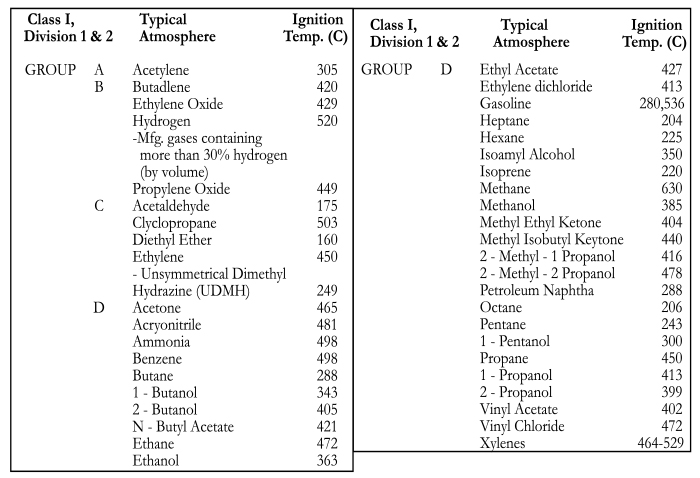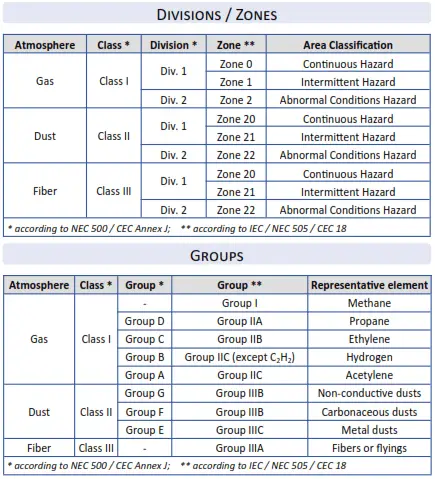class ii division 2 group g
The top 20 schools in both Division I regions are shown below. Class II Division 2.

Common Core Math Cheat Sheets For Grades K 5 Common Core Math Standards Common Core Math Math Cheat Sheet
They are calling it Class II Div II group G My question is do I have to use explosion proof receptacle or do they make something more.

. Class II Group G Atmospheres containing combustible dusts not included in Group E or Group F including flour grain wood plastic and chemicals. Class II because of combustible dust. Atmospheres containing combustible dusts not included in Group E or Group F including flour grain wood plastic and chemicals.
Group D because propane is in the atmosphere. And Class II Divisions 1 and 2 Groups E F and G for hazardous locations. Our dust ignition protected vacuum systems are osha nrtl certified for use in class ii division 2 groups f g hazardous locations zone 22 for dust group iiic conductive dusts.
In Class II Div. These fine particles can float and collect on equipment in the surrounding areas. Schools in Divisions II through VII are each divided into four regions.
Use these switches where ignitable gas and dust may be present. However Class 1 and 2 motors are grouped by your specific hazardous substance. NEMA and UL designations for dusttight equipment are Types 3 3S 4 4X 6 6P 12 12K and 13.
2 provide this equipment with enclosures that are dusttight or identified for the location 502115 502120. And Group G is for non-conductive dust like flour grain and plastic. Class ii division 2 group g.
Group define the type of hazardous material and partly the location of the surrounding atmosphere. Group F is for carbonaceous dust like charcoal coal and carbon black. Class II Division 2 Groups F and G Explosion Proof Lights These fully-sealed durable explosion proof LED lights provide lighting within potentially dangerous spaces where ignitable vapors and gasses are present.
Motor accessories must be non-sparking or approved for Explosion Proof XP duty. Class II Division 1 is in an area where dust material is handled manufactured or used. Work with GT Independence as your FMS provider and call 8776594500 to schedule your.
Division I because dust is present during normal operation. 1 locations provide electrical controls eg switches breakers control transformers and resistors with enclosures identified for use in the location 502115 502120. Group II is for explosive gases Zone 0 1 and 2 and Group III.
NEMA Type 9 enclosures dust ignitionproof are also accepted Reading the above it would appear that a NEMA4 enclsoure and operators lights etc. What is accepted in the USA. Class II Div II receps in cabinet shops Ive been reading a lot on article 502-115 502-145 and speaking to the local authorities on the requirement for receptacles around wood working equipment.
The most common groups and materials are listed below. Group is divided in three groups where Group I is reserved for mining locations. 866-590-3533 Same Day Shipping If.
Per the National Electrical Code NEC there are 3 classifications for areas that are defined as hazardous. Locations with combustible dusts. Division II because flammable vapor would only leak from the tanks if there was an accident.
Once eligible let your SSA know you want to direct your own services with participant-direction. As required by Underwriters Laboratories and Canadian Standards Association explosion-proof motors with Class II Group F G approvals must have over temperature protection. Class II locations are those that are hazardous because of the presence of combustible dust.
The IP rating and Explosionproof rating are different. Find your county board for developmental disabilities and determine your elegibility. All IP67 rating equipments can not be used in classified area.
Ambient may not exceed 60C make addition for higher than 40C ambient as required. Group G because grain dust is in the atmosphere. Any grounding provisions must be in the main conduit box.
Class ii division 1 groups e f g. Choose from our selection of Class II Division 2Group G switches in a wide range of styles and sizes. Atmospheres containing combustible carbonaceous dusts such as coal carbon black charcoal and coke dusts.
In stock and ready to ship. Class II Group G. They are Class I gases vapors Class II flammable dusts Class III fibers the focus of todays Blog is on Class II locations.
As you can see by the breakdown groups a b c and d are for class i gases only. Class II locations are divided into three groups EFG. The top eight teams in each region will qualify for the playoffs.
Class I because of flammable vapor. They meet NEC Class I Divisions 1 and 2 Groups B C and D. Class II location groups are determined by.
Locations with ignitable fibers and flyings. When an object in motion comes into contact with the actuator it sends a signal to open or close a circuit. Propane tank storage room.
Note that the dust must be present in. Class II Division 2 is where. For outdoor application in Class II Div2 Group G you can very well use combination of NEMA 4 very approximate equivalent to IP 66 NEMA 9 For hazardous locations enclosure.
For outdoor application in Class II Div2 Group G you can very well use combination of NEMA 4 very approximate equivalent to IP 66 NEMA 9 For hazardous locations enclosure. Material Groups Dust Class II Group F. Group d propane class ii dust division 1 division 2 group e metal dusts group f carbon-based dusts group g non-conductive dusts class iii fibers flyings hazardous location classifications controls for hazardous locations atex iecex probability of hazardous material zone 0 20 zone 1 21 zone 2 22.
The Class 3 motor is the least common and isnt divided any further into groups. Motors suitable for Class II Groups F G Division 2 are available in TEFC TEFC-XT TEBC TEAAC and TEWAC only. Would be acceptable for a Class II Division 2 Group FG hazardous area.
Class II Group F G locations are atmospheres containing dust such as F Carbon Black coal or Coke Dust G Flour Starch or Grain Dusts. The ignition temperature of the dust the electrical conductivity of the dust and the thermal blanketing effect the dust can have on heat-producing equipment such as.

3rd Grade Math Multiplication And Division Part 1 Hands On Fun 3rd Grade Math Math Multiplication And Division

Five For Friday Teaching Multiplication Math Notebooks Third Grade Anchor Charts

Word Problem Anchor Chart Word Problem Anchor Chart Math Word Problems Anchor Chart Math Strategies Anchor Chart

Get Is A Strategy For Identifying Multiplication And Division Fact Families It Breaks Down The Concept O Math Strategies Posters Math Strategies Anchor Charts

Hazardous Location Classification

3rd Grade Math Multiplication And Division Part 1 Hands On Fun 3rd Grade Math Math Teaching Grade

Multiplying 4s And 9s Facts Color By Code Multiplication Facts Math Coloring Math Center Games

Group Theory Proof If G N E Then The Order Of G Divides N Group Theory Math Videos Maths Exam

Introduction To Multiplication Guruparents Teaching Multiplication Multiplication Worksheets Multiplication

Over 100 Brain Teasers For Kids Brain Teasers For Kids Brain Teasers Mind Games For Kids

Understanding Hazardous Area Classification Inst Tools

Math Board Games Bundle 8th Grade 8 Ns 8 Ee 8 F 8 G 8 Sp Math Board Games Math Boards Math

Kids Are Loving These Games During Rotation Time To Reinforce Standards This 3rd Grade Geometry Games Pack Include 3rd Grade Math Math Centers Math Geometry

Dividing Decimals By Whole Numbers 5 3g Dividing Decimals Decimals Decimal Division

The Vertically Arranged Division Facts To 64 G Math Worksheet Page 2 Division Facts Math Drills Subtraction

Division Word Problems Boom Cards Division Word Problems Word Problems Math Lesson Plans

